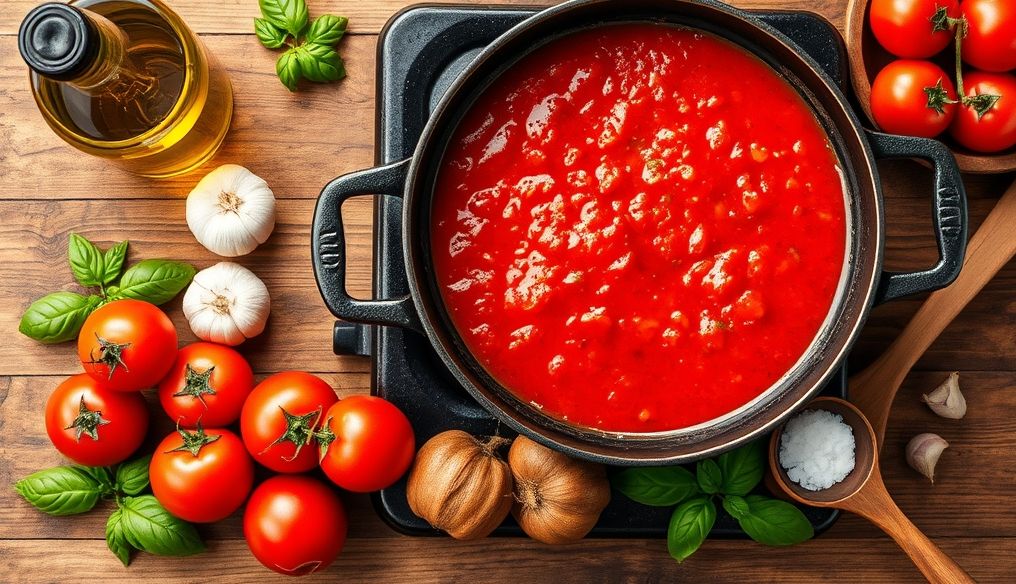How to Make the Perfect Tomato Sauce for Pasta at Home?
Tomato sauce is a cornerstone of Italian cuisine, and the base for many delicious dishes, most notably pasta. There's nothing quite like making homemade tomato sauce, as it adds a distinct and fresh flavor to your meal. In this article, we'll explore the steps to making the perfect tomato sauce, from selecting ingredients to cooking techniques.
Chapter 1: Choosing the Essential Ingredients
1.1 Tomatoes: The Heart of the Sauce
Tomatoes are the main ingredient, and their quality greatly affects the final result. Here are some tips:
- Type: Italian San Marzano tomatoes are considered the best, as they have dense flesh, natural sweetness, and few seeds. If they are not available, Roma tomatoes or any other type of ripe red tomatoes can be used.
- Fresh vs. Canned: Fresh tomatoes are ideal in their season (summer and autumn). In other seasons, canned tomatoes (peeled or crushed) are a good option, but be sure to choose a high-quality brand.
- Ripeness: Tomatoes should be fully ripe, with a deep red color and a fragrant aroma. Avoid green or hard tomatoes.
1.2 Olive Oil: Flavor and Texture
Olive oil adds a distinctive flavor and silky texture to the sauce. Use Extra Virgin Olive Oil for best results. Avoid other vegetable oils, as they do not give the same rich flavor.
1.3 Garlic and Onions: The Aromatic Base
Garlic and onions are the foundation of flavor in many sauces. Use fresh garlic and yellow or white onions. Quantities depend on your personal taste, but generally, use two cloves of garlic and a medium onion per kilogram of tomatoes.
1.4 Herbs and Spices: The Finishing Touch
Fresh or dried herbs add depth and complexity to the sauce. Here are some common options:
- Basil: Adds a fresh and aromatic flavor.
- Oregano: Gives an earthy and warm flavor.
- Parsley: Adds a light and refreshing flavor.
- Red Pepper Flakes: To add a touch of heat (optional).
- Sugar: Balances the acidity of the tomatoes (optional).
- Salt and Black Pepper: To season the sauce.
Chapter 2: Preparing the Tomatoes
2.1 Peeling Fresh Tomatoes (Optional)
Peeling the tomatoes gives a smoother sauce, but this step can be skipped if you prefer a sauce with a coarser texture. Here's how to peel:
- Make an X-shaped cut at the bottom of each tomato.
- Place the tomatoes in a bowl of boiling water for 30-60 seconds.
- Transfer the tomatoes to a bowl of ice water.
- Peel the tomatoes easily using a small knife.
2.2 Chopping the Tomatoes
Cut the tomatoes into small cubes or mash them using a food processor. If you are using crushed canned tomatoes, you can skip this step.
Chapter 3: Cooking the Sauce
3.1 Preparing the Aromatic Base
In a large saucepan over medium heat, heat the olive oil. Add the chopped onion and sauté until golden and translucent (about 5-7 minutes). Add the minced garlic and sauté for one minute until fragrant. Be careful not to burn the garlic.
3.2 Adding the Tomatoes
Add the chopped or mashed tomatoes to the saucepan. Raise the heat to medium-high until the sauce starts to boil. Then reduce the heat to low, partially cover the saucepan, and let the sauce simmer for at least an hour, or until it reaches the desired consistency. The longer the cooking time, the sweeter and more concentrated the sauce becomes.
3.3 Seasoning and Improving
After an hour, add the herbs and spices (basil, oregano, parsley, red pepper flakes, sugar, salt, black pepper). Taste the sauce and adjust the seasonings as desired. If the sauce is too acidic, add more sugar. If it is bland, add more salt or black pepper.
3.4 Adding a Finishing Touch (Optional)
For a smoother sauce, you can use an immersion blender to mash the sauce directly in the saucepan. Alternatively, you can pass the sauce through a fine-mesh sieve to remove any seeds or skins.
Chapter 4: Additional Tips for Improving the Sauce
- Adding Vegetables: You can add other vegetables to the sauce, such as carrots, celery, and bell peppers, to add more flavor and nutrition.
- Adding Meat: To make Bolognese sauce, add ground beef or ground pork to the sauce.
- Adding Wine: To add a complex flavor, add half a cup of dry red wine to the sauce after browning the onions and garlic. Let it evaporate before adding the tomatoes.
- Using Chicken or Vegetable Broth: Instead of water, you can use chicken or vegetable broth to add more flavor.
Chapter 5: Storing the Sauce
Tomato sauce can be stored in the refrigerator for up to 5 days, or in the freezer for up to 3 months. To freeze the sauce, place it in freezer bags or airtight containers, and leave a small space for expansion.
Chapter 6: Uses of Tomato Sauce
Tomato sauce is versatile and can be used in many dishes, including:
- Pasta (spaghetti, penne, fusilli, etc.)
- Pizza
- Lasagna
- Soups and Stews
- Dipping Sauces
Chapter 7: Simple Tomato Sauce Recipe
This is a simple and quick recipe for tomato sauce:
Ingredients:
- 1 kg peeled and chopped tomatoes
- 2 cloves garlic, minced
- 1 medium onion, chopped
- 2 tablespoons olive oil
- 1 teaspoon dried oregano
- 1/2 teaspoon sugar (optional)
- Salt and black pepper to taste
Instructions:
- Heat the oil in a saucepan over medium heat.
- Add the onion and garlic and sauté until softened.
- Add the tomatoes, oregano, sugar, salt, and pepper.
- Bring the sauce to a boil, then reduce the heat and let it simmer for 30 minutes.
- Serve the sauce with your favorite pasta.
Chapter 8: Conclusion
Making the perfect tomato sauce at home is not difficult. By following these tips and recipes, you can enjoy a delicious and healthy tomato sauce that rivals the best Italian restaurants. Enjoy experimenting with flavors and creating in your kitchen!




